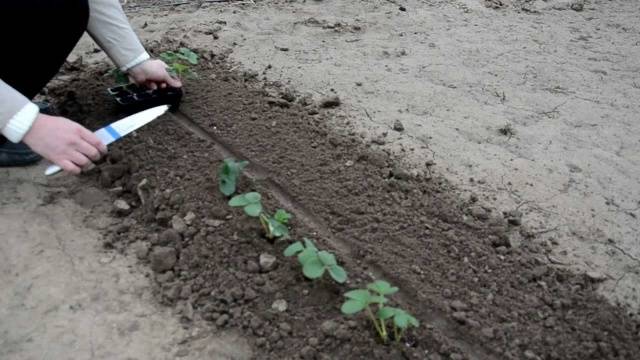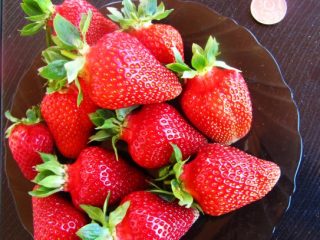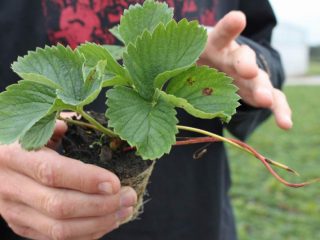Content
Remontant strawberries allow you to enjoy delicious berries throughout the summer season. Such varieties bear fruit in 2 stages or continuously, in small portions from early spring to late autumn. Having decided grow repair work on your land plot strawberries, you need to know the features of caring for plants so that they can fully demonstrate their advantageous qualities. So, in addition to pruning, weeding and watering, it is very important feeding remontant strawberries. Giving up a large number of berries, the plants quickly become depleted and begin to produce low-quality fruits: small, ugly, sour. You can correct the situation and provide the crop with enough strength for long-term fruiting with the help of various fertilizers and fertilizers, which must be used several times during the season. Learn how to properly care for remontant strawberries and what fertilizers to use at different stages growing season can be found in the article below.
Features of remontant strawberries
Farmers distinguish 3 types of remontant strawberries depending on the conditions of fruit bud formation:
- Conventional varieties prepare for fruiting next year only during short daylight hours, that is, in the second half of summer - early autumn.
- Remontant varieties (“Lyubava”, “Geneva”, “Brighton”) are capable of laying a fruit bud with long daylight hours (16 hours a day). Thus, the first buds of a remontant plant begin to appear in mid-May, the second stage of formation occurs at the end of summer. Such strawberries bear fruit twice per season: in summer and early autumn.
- Remontant day-neutral strawberries (“Queen Elizabeth II”, “Diamant”, “Referenta”) set fruit buds constantly, regardless of the lighting conditions. The growing season of such strawberries is cyclical: the berries ripen and new flowers form every 6 weeks. Strawberries of these varieties delight with their taste from mid-spring to late autumn.
The advantage of remontant strawberries, in addition to the long fruiting period, is their high yield. During the season, you can collect up to 3.5 kg of berries from each bush. However, to obtain such a high result, it is necessary to properly care for the crop, providing regular watering and fertilizing. With insufficient care, it will not be possible to obtain a high yield. At the same time, having devoted all their efforts to the formation and ripening of fruits, remontant strawberries may even die at the end of the season.
Many gardeners claim that remontant strawberries, as the harvest progresses, produce small berries with low taste quality and often suffer from diseases and pests. In order to prevent such a result, it is necessary to carefully study the characteristics of a particular variety of remontant crop and care for the plants properly. For example, some remontant varieties are resistant to diseases and produce consistently large berries with high taste characteristics. It is also worth paying attention to the ability of remontant plants to form mustaches. This will allow strawberries with a relatively short life cycle to be propagated without much hassle.
Methods of growing crops
If desired, strawberries can be grown year-round in an apartment. True, in this case one cannot count on a large amount of harvest. Growing strawberries in greenhouses has long been practiced in the West. That is why sometimes, even in the middle of winter, you can see attractive, fresh berries on store shelves. In domestic latitudes, strawberries are often grown in open areas of land. To do this, ridges are formed and young bushes are planted in a checkerboard pattern, maintaining certain distances. This widespread technology has one significant drawback: the berries, in contact with damp soil, often rot. For pests, such an environment is also an excellent “springboard” for existence and parasitism.
The most advanced technology is growing strawberries under film. To do this, the formed ridge is covered with geotextile or polyethylene. Holes are made in the covering, into which young remontant plants are subsequently planted.Thus, the mature crop will not come into contact with the soil, the tendrils that form can be easily removed, and you can completely forget about weeding the ridges.
This growing technology is described in detail in the video:
In practice, there is another technology for hanging strawberries. To do this, seedlings of remontant plants are planted in containers filled with soil and hung according to the flowerpot principle. This method allows you to get a small amount of berries and a pot with high decorative qualities.
Cultivation stages
Remontant strawberry requires a lot of attention and care, starting from the moment of preparing the soil for planting plants until the end of their life cycle. That is why, having decided to grow remontant berries, you need to have patience and knowledge that will help you timely and correctly carry out all the necessary measures to get a decent harvest.
Applying fertilizers to the soil
To grow strawberries, you need to choose a sunny piece of land, without flooding. Strawberries do not tolerate high humidity and standing water. In such conditions, its roots and fruits begin to rot.
As with any crop, good and bad predecessors can be distinguished for strawberries. For example, farmers recommend growing garden strawberries after onions, garlic, radishes, carrots, and legumes.
Strawberries can grow in any soil, but it is preferable to grow them in nutritious soil.To create a good substrate, you need to add compost or rotted manure to the soil at a rate of 4-6 kg/m2. It would be a good idea to sprinkle the soil with wood ash. In the soil mixture its share should not exceed 10%. If sawdust is available, they can also be added to the soil in an amount of 20%. This soil composition will contain the necessary amount of nitrogen, potassium and phosphorus for the normal growth of strawberries after planting in the ground.
You can also fertilize the soil for growing remontant strawberries using mineral fertilizers. For every 1m2 add 6-8 g of ammonium nitrate or urea to the soil, as well as 30 g of superphosphate and 10 g of potassium chloride. This composition can be replaced with the complex fertilizer “AgroPrirost”. Fertilizer consumption can reach 3 kg/m2.
Methods of growing and feeding seedlings
Before you start planting strawberries in the ground, you need to get planting material. The most difficult way is to grow strawberry seedlings from seeds. The grains can be purchased or collected from already ripe remontant berries. To store them, they must be thoroughly dried, and before planting, soaked in water or a nutrient solution, a growth stimulant. To do this, you can use “Epin”, “Ovary” or another biological preparation. You can grow seedlings in soil whose composition is similar to that given above. Conditions for growing seedlings require a temperature of +20-+220C and very high humidity – up to 85%. Seedlings should be fertilized when the first leaves appear. "Bio Master" or "Uniflor-Rost" can be used as a complex mineral fertilizer for remontant strawberries during this period. This method of obtaining planting material is relevant for varieties that do not form mustaches.
You can see a clear example of growing strawberries from seeds in the video:
If a remontant strawberry variety produces a certain amount of tendrils during cultivation, then they can be safely removed from the bush and planted in the so-called mother bed. This will allow existing, fruit-bearing remontant strawberry bushes to devote all their energy to ripening the crop, without providing nutrients to the resulting mustache. On the mother bed, the planted rosettes should gain sufficient strength, after which they can be transplanted to the main bed.
In addition to the above methods, strawberries can be propagated by dividing the roots of already mature bushes. Seedlings can also be purchased at agricultural fairs and markets.
Planting seedlings in the ground
Young plants can be planted in the ground in mid-autumn or early spring. To do this, holes are made on the formed ridges according to a certain pattern. It is preferable to place seedlings in beds in 2-3 rows in a checkerboard pattern, maintaining a distance of 30-35 cm between bushes. Planting seedlings according to this scheme will protect remontant plants from pests and diseases and ensure normal air circulation. Each bush with this arrangement will receive a sufficient amount of light.
If mineral fertilizers (superphosphate, potassium chloride) were not used when digging the soil, they can be added to the holes immediately before planting.Strawberry seedlings must be removed from the cups, leaving the soil still standing. Strawberry roots over 10 cm long should be trimmed. The planting hole must be deep enough so that the roots of the remontant plant can be positioned vertically in it without bending. The root collar of the bush should be placed above the ground. After planting the plants, the holes with remontant strawberries should be watered and mulched.
This nuance forces gardeners to plant strawberries more and more often in the fall, in September. These plantings will have time to take root and become stronger by the winter season. The tendrils produced by the plants should be removed. For the winter, it is recommended to cover the beds with remontant strawberries with protective material and mulch them.
Basic care
Repair culture requires a special attitude. She is ready to give a rich berry harvest only in exchange for competent, painstaking and regular care. It consists of several main events:
Watering
Remontant plants need to be watered frequently and abundantly. It's better to do this early in the morning. Before the strawberries begin to bloom, you can water them with a watering can by sprinkling. With the onset of flowering, watering must be done carefully at the root. Drops of water on the berries can cause them to rot.
The number of fruits and their juiciness largely depends on watering, so during the flowering period for every 1m2 The soil should contain at least 10 liters of water. The liquid temperature should be approximately +200C. Watering with cold water significantly slows down the growth of the plant.
Weeding
Caring for beds with remontant strawberries, including regular weeding. It is necessary to remove varietal grasses carefully so as not to damage the roots of the plants. Weeding should be combined with loosening and mulching. Loosening will allow the roots to receive the necessary oxygen, and mulching will retain moisture in the soil. Straw and pine branches can be used as mulch. When cleaning the beds, you should also remove litter, red and dry leaves.
Feeding remontant strawberries
If you water, weed, and loosen remontant strawberries regularly, as needed, then you need to fertilize and feed remontant plants depending on the stage of the growing season, strictly according to the schedule. This will allow them to constantly receive the necessary nutrients and replenish their strength for the next stage of fruiting.
With proper feeding, remontant berries will be distinguished by their abundance, size, juiciness, and excellent taste throughout the entire fruiting period.
Fertilizing in spring
The first spring fertilizing should be done immediately after the snow melts. At this time, you need to trim the bushes and apply nitrogen fertilizer, which will help remontant strawberries grow the required number of fresh leaves.
Nitrogen can be obtained from organic or mineral fertilizers:
- Mullein can be an organic source of the substance. Half a liter of cow dung infusion should be diluted in a bucket of water. Water the remontant strawberry bushes with the resulting solution, 1 liter per root.
- The complex mixture “Nitroammofoska” can be used as a mineral fertilizer. To prepare a nutrient solution, dilute 1 spoon of the substance in a bucket of water.For each strawberry bush there should be no more than 500 ml of the resulting fertilizer.
- Nettle infusion can be a natural organic fertilizer for strawberries. To do this, add chopped greens to water and leave for 3-4 days. The infusion can be used as a root feed, when diluted with water 1:10, or as a foliar feed, reducing the concentration of the original solution by 20 times.
In addition to the listed fertilizers, you can use an infusion of chicken manure to feed remontant strawberries in early spring. Before flowering, nitrogen fertilizers need to be fed to the plants twice.
Feeding during flowering
Starting from mid-May strawberries begin to bloom profusely. During this period, remontant plants need potassium. A sufficient amount of this mineral makes the berries especially tasty and sweet. Their appearance and transportability are also improved under the influence of potassium.
You can provide potassium to strawberry bushes in the form of root and foliar feeding:
- You can water the root of the plant with a solution of potassium nitrate. A teaspoon of this substance is dissolved in 10 liters of water. Fertilizer consumption should be no more than 500 ml for each bush.
- It is recommended to spray strawberries during flowering with a solution of zinc sulfate. The concentration of the solution should not exceed 0.02% (2 g per 10 liters of water).
- High efficiency is shown by spraying remontant strawberry bushes with boric acid (5 g per 10 liters of water).
Different types of feeding cannot be combined. The break between their use should be 7-10 days.At the end of flowering, during fruit ripening, it is not recommended to use mineral fertilizers, since the substances can accumulate in large quantities in the berries.
After harvesting the first wave of the harvest, feeding remontant plants can be repeated cyclically, this will improve the quality of the berries at the second stage of ripening.
Fertilizing strawberries after fruiting
Having harvested remontant strawberries twice, do not forget about fertilizing, because it is in the fall that the plants lay a fruit bud for the next year. Nitrogen fertilizers should not be used after the end of fruiting, as this will cause active growth of remontant bushes, as a result of which they will not be able to properly prepare for wintering.
After harvesting the second wave of the crop, you need to feed the crop with potassium fertilizers. To do this, you can use potassium sulfate or potassium nitrate. However, natural, folk supplements in this case are the best option.
Fertilizing with wood ash
Wood ash contains a lot of micronutrients. It is added to the soil when planting crops, and is also used to fertilize strawberries. To do this, the ash is scattered in the root circle of the plant, embedding it into the soil by loosening it.
To feed remontant strawberries, you can use an ash infusion prepared by adding 1 liter of ash to a bucket of water. The solution is infused for several days, after which it is further diluted with water to obtain a light gray liquid.
Using Yeast
Mineral fertilizer for remontant strawberries can be prepared from yeast or yeast bread:
- Yeast is added to warm water (1 kg per 5 l). A spoonful of sugar will help speed up fermentation. The resulting solution is further diluted with water 1:20 and used for watering plants at the roots.
- Soak the bread crusts in warm water and leave the solution for a week, after which the pulp is placed on the ground around the perimeter of the plant roots and loosened into the soil.
During fermentation yeast They emit gases, heat, and force beneficial microflora to intensify their activity, decomposing organic matter in the soil.
Iodine – protection against pests
Iodine helps protect strawberries from pests and diseases. It must be used for preventive purposes every 10 days. To do this, add 8-10 drops of iodine to a bucket of water and spray the remontant strawberry bushes with the resulting liquid.
A full range of measures for caring for remontant strawberries should include at least 7-8 feedings per season. Depending on the stage of vegetation, you should choose substances with the necessary microelement complex. Some other points related to caring for remontant strawberries can be emphasized from the video:
Conclusion
Tasty, juicy remontant strawberries, ripening throughout the summer, are the result of the gardener’s hard work. Healthy planting material, properly prepared nutrient soil and adherence to the planting scheme are the basis for the successful growth of plants.As strawberries grow and develop, they increasingly deplete the soil and require additional fertilizers. You can feed the crop with mineral fertilizers, organic matter or other available products. With regular fertilizing, plants will not experience a lack of microelements. In combination with abundant watering, timely weeding and loosening, fertilizing will give an excellent result in the form of a bountiful harvest of berries of excellent taste.























Everything is intelligible and understandable. Thank you. I would like to know about the features of growing day-neutral garden strawberries in a winter greenhouse